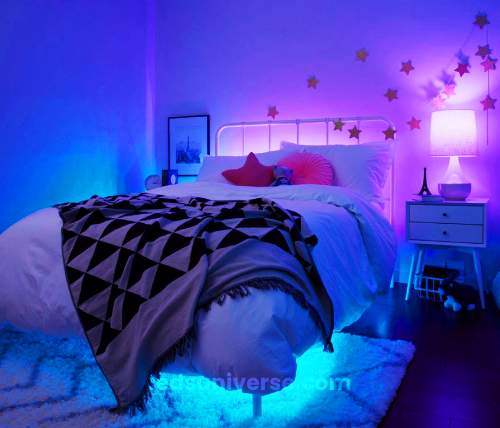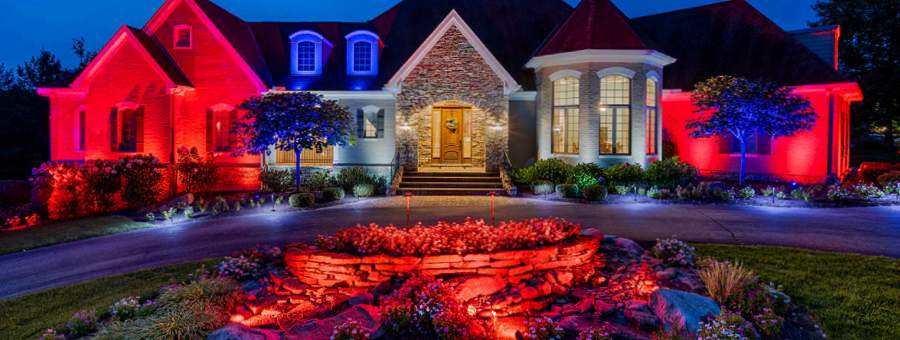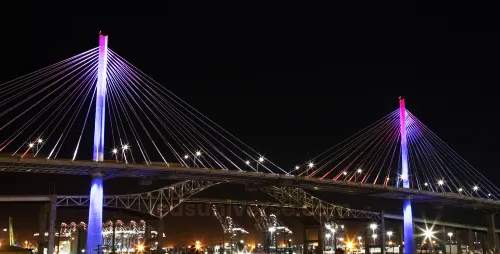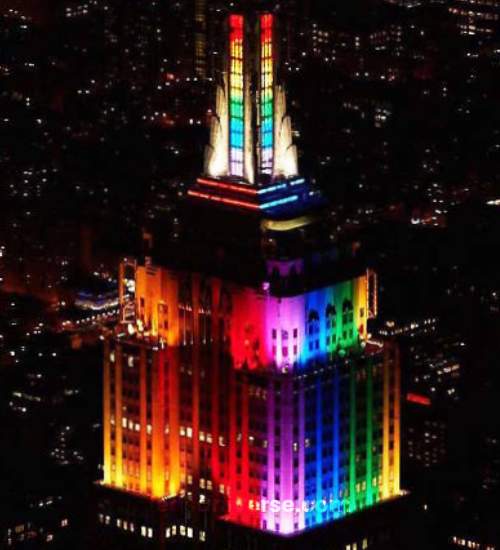Lighting technology has evolved to transform our surroundings in extraordinary ways, turning everyday spaces into vibrant spectacles. With the ability to shift colors and intensities, this innovation breathes new life into everything from city bridges to building facades. Explore how this dynamic approach to illumination is reshaping environments, making both ordinary moments and architectural marvels more engaging and visually stunning.
Color-changing lighting has become a fascinating element in modern design, transforming spaces with its dynamic and versatile capabilities. From residential interiors to large-scale public installations, color-changing lights offer unique opportunities to enhance ambiance and functionality. We will discuss the technology behind these lights, explores their diverse applications, and examines their impact on environments such as bridges and building facades.
Reach out for free lighting consultation
Table of Contents
ToggleAt the core of color-changing lighting is the advancement in LED (Light Emitting Diode) technology. LEDs have revolutionized the lighting industry due to their efficiency, longevity, and versatility. Among LEDs, RGB (Red, Green, Blue) LEDs stand out for their ability to produce a wide spectrum of colors by adjusting the intensity of each color component. By blending these primary colors, RGB LEDs can create virtually any color in the visible spectrum.
Additionally, RGBW LEDs, which include a white light component along with the red, green, and blue elements, provide enhanced color rendering and the ability to produce warmer or cooler light tones. This expansion allows for more nuanced lighting effects and improved overall visual quality.
Beyond color changing, many LED systems offer dimmable and tunable features. Dimmable LEDs allow users to adjust the brightness of the light, which can contribute to creating a more comfortable or dramatic atmosphere depending on the setting. Tunable LEDs, on the other hand, enable adjustments in color temperature, shifting from warm to cool tones. This capability supports various applications, from enhancing the mood in a living room to improving productivity in a workspace.
The integration of smart technology into lighting systems has further expanded their possibilities. Smart lighting systems connect to home or building networks and can be controlled via smartphone apps or voice assistants. This connectivity allows for sophisticated scheduling, scene creation, and remote control, making it possible to adjust lighting settings with ease and precision. Smart lighting systems can also integrate with other smart home devices, creating synchronized environments that respond to users’ preferences and needs.

In residential settings, color-changing lighting can transform ordinary spaces into personalized havens. Ambient lighting, such as ceiling fixtures and floor lamps, can set the mood for different times of the day or activities. For instance, a warm, soft light may create a cozy atmosphere in the evening, while cooler, brighter tones might be preferable during the day for tasks requiring concentration.
Accent lighting, such as LED strips or spotlights, can highlight architectural features or artworks, adding depth and interest to the room. Task lighting, which focuses on specific areas like kitchen counters or reading nooks, can also benefit from color-changing capabilities to adjust the light for various tasks.
In commercial spaces, color-changing lighting serves both aesthetic and functional purposes. Retail environments often use dynamic lighting to attract customers and highlight merchandise. The ability to alter colors can create engaging displays and adapt to seasonal themes or promotional events.
Office spaces benefit from color-changing lighting by enhancing productivity and reducing eye strain. Adjustable lighting can align with natural circadian rhythms, promoting a healthier work environment. In hospitality settings, such as hotels and restaurants, color-changing lighting can contribute to a more inviting and memorable guest experience, with the ability to adjust ambiance according to the time of day or special occasions.

Outdoor color-changing lighting extends its influence to landscapes and architectural features. Garden and landscape lighting can create dramatic effects, transforming outdoor spaces into visually striking areas. Pathways, trees, and water features can be illuminated with varying colors to enhance their appearance during nighttime.
Architectural lighting plays a significant role in highlighting the design of buildings and structures. Color-changing lights can accentuate architectural details, bringing attention to specific elements and creating visual interest. This technique is often used in urban settings to enhance the aesthetic appeal of public spaces and landmarks.
Event and seasonal lighting also benefit from color-changing technology. Temporary installations for events or holidays can use dynamic lighting to create festive and engaging environments. The flexibility of color-changing lights allows for quick and impactful transformations, making them ideal for a wide range of occasions.

Bridges are not only functional structures but also significant landmarks that can benefit from color-changing lighting. The application of dynamic lighting to bridges can enhance their visibility and contribute to the overall aesthetic of a cityscape. By using color-changing LEDs, designers can create various lighting effects that highlight the bridge’s architectural features and improve its nighttime visibility.
For instance, bridges can be illuminated with a range of colors to mark special events or holidays, providing a vibrant display that contributes to community celebrations. Additionally, dynamic lighting can enhance the visual appeal of bridges during different times of the year, offering a changing panorama that reflects seasonal themes or artistic designs.

Building facades present a unique opportunity for color-changing lighting to make a significant impact. The exterior of a building can be transformed into a canvas for artistic expression or branding through the use of dynamic lighting. Color-changing LEDs can highlight architectural details, such as columns, windows, and textures, creating a visually captivating effect that varies throughout the day or night.
Facade lighting can also be used for more functional purposes, such as improving visibility and safety in urban environments. For example, color-changing lights can be used to guide people or indicate entrances, contributing to both aesthetic and practical aspects of building design.
Moreover, building facade lighting allows for thematic displays that align with cultural or corporate events. The ability to change colors and patterns offers a versatile tool for creating memorable impressions and enhancing the building’s role within the community.
Color-changing lighting has transformed how we experience and interact with our environments. In residential settings, it enhances the atmosphere and provides flexible lighting solutions. In commercial and public spaces, it contributes to both functionality and visual appeal, making spaces more engaging and adaptable.
The application of color-changing lighting to bridges and building facades demonstrates its ability to enhance the urban landscape. By highlighting architectural features and creating dynamic visual effects, color-changing lighting adds a new dimension to how we perceive and enjoy public spaces.
As technology continues to advance, the potential for color-changing lighting to innovate and inspire will likely expand. The ongoing development of LED technology, smart systems, and creative design approaches will further enrich our experience of light and its role in shaping our surroundings.
The continued evolution of color-changing lighting technology promises even greater possibilities for transforming spaces and enhancing experiences. The integration of advanced LED systems and smart technologies is reshaping how lighting is used in both residential and commercial settings, and its application to architectural features such as bridges and building facades continues to push the boundaries of creative design.
Recent advancements in LED technology are driving the evolution of color-changing lighting. Innovations such as micro-LEDs and OLEDs (Organic Light Emitting Diodes) offer even greater flexibility and efficiency. Micro-LEDs, for instance, are known for their high brightness, color accuracy, and energy efficiency. They can be used to create more compact and versatile lighting solutions that fit into a variety of applications, from tiny electronic devices to large-scale displays.
OLEDs, with their ability to produce uniform light over a broad area, provide new opportunities for lighting design. Their flexibility allows them to be integrated into various surfaces and shapes, offering innovative ways to incorporate color-changing light into architectural elements. This flexibility can lead to the development of new types of illuminated surfaces and interactive lighting experiences.
The convergence of color-changing lighting with augmented reality (AR) and virtual reality (VR) is an exciting frontier in lighting design. AR and VR technologies can create immersive environments where color-changing lighting plays a crucial role in enhancing the virtual experience. For example, in VR environments, color-changing lights can simulate different times of day, weather conditions, or emotional atmospheres, providing users with a more engaging and interactive experience.
In architectural design, AR can be used to visualize how color-changing lighting will look in a real-world setting before installation. This allows designers to experiment with various lighting scenarios and make informed decisions about how lighting will impact the overall design. The integration of AR and VR with color-changing lighting opens up new possibilities for creating dynamic and responsive environments.
Sustainability is becoming increasingly important in lighting design, and color-changing lighting is no exception. Advances in LED technology have already contributed to energy efficiency and reduced environmental impact. LEDs consume significantly less energy compared to traditional incandescent and fluorescent lights, leading to lower carbon emissions and reduced energy consumption.
Furthermore, many manufacturers are now focusing on developing lighting solutions that use recyclable materials and have longer lifespans, further contributing to environmental sustainability. The ability to control and adjust lighting also helps in reducing light pollution, as it allows for more precise targeting and minimizes excessive light spill.
One of the considerations when adopting color-changing lighting is the cost of installation and equipment. While the long-term benefits of LEDs, such as energy savings and reduced maintenance, can offset the initial investment, the upfront cost of purchasing and installing advanced color-changing systems can be significant. Budgeting for these systems involves considering not only the equipment but also the complexity of installation and any necessary infrastructure adjustments.
Another factor to consider is compatibility with existing lighting systems. Integrating color-changing lighting into an existing setup may require additional modifications or upgrades to ensure seamless operation. It is important to assess the current infrastructure and determine any necessary changes to accommodate new technology, especially in retrofitting older buildings or installations.
Maintaining color-changing lighting systems involves understanding their durability and lifespan. Modern LEDs are known for their longevity compared to traditional bulbs, but ensuring proper maintenance is still crucial. Regular checks and updates to software or control systems can help prevent issues and ensure that the lighting continues to perform as intended.
Color-changing lighting systems should be designed with consideration for light pollution, which can affect both human health and wildlife. Effective lighting design involves using technologies that minimize light spill and glare, ensuring that lighting enhances rather than detracts from the environment. This includes using shielded fixtures, precise beam angles, and adaptive controls to manage light levels.
Color-changing lighting represents a significant advancement in how we experience and utilize light in various settings. The technological innovations driving this field continue to expand its possibilities, offering new ways to enhance residential, commercial, and public spaces. From the dynamic illumination of bridges and building facades to the integration with smart systems and sustainable practices, color-changing lighting is reshaping our approach to design and environment.
As the technology evolves, it will likely bring even more creative and practical solutions, further enriching our interactions with light and contributing to more vibrant and responsive spaces. The ongoing development in LED technology, coupled with innovations in smart control systems and sustainability, promises a future where color-changing lighting continues to play a transformative role in shaping our surroundings.